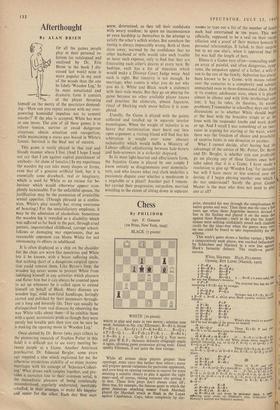Chess
By PHILIDOR 24o. F. GAMAGE (nit Prize, New York, 3943) BLACK (7 pieces) WHITE (to pieces)
WHITE to play and mate in two moves ; solution next week. Solution to No. 239 (Ellerman). R—Kt 6, threat P—B 7. Kt—Q 2; 2 P—K 8=Kt. B—Q 2; 2 PxB=Q. R xP ch; 2 Px R. B—Kt 6 ; 2 B—Kt 3. 3 . . . Q—B ; 2 Q—Q 5. Key move self pins W K P ; thematic defences obligingly unpin it again, allowing pawn promotion giving mate. Good quality Ellerman, if not quite the best vintage. '
While all serious chess players prepare their openings, some carry this farther than others ; many will prepare special variations for particular opponents, and even keep an opening variation in reserve for years awaiting a suitable chance to play it against the right manand, of course, risking someone else getting it in first. These little ploys don't always come off ; there was, for example, the famous game in which the great American attacking master Frank Marshall played the Marshall attack as Black in the Lopez against Capablanca. Capa, taken completely by sur- prise, threaded his way through the complications by native genius and won. Then there was the case a fey years ago when three Argentine masters devised 9 line in the Sicilian and played it on the same de against three Russians ; early in the play the Argil" tinians were walking confidently round each claiming credit for the idea—but when the games were over no one could be found to take responsibility for the scheme.
This week's game shows a further variant ; White) a comparatively weak player, was coached beforehand by Schlechter and Maroczy in a new line against Black's favourite defence. The result—a partici
success.
67 p_. . .W2hRit4e, HPKAIPx/181N3 . Black, PILLSBURY, Opening, Ruv LOPEZ (Munich, 1900)
1 P—K 4 P—K 4 2 Kt—K B 3 Kt—Q 2 3
3 B—Kt5 KKtt—xpB3 '
4 0-0
5 P—Q 4 the text was PillsburyK'st—favQour3ite. 5 ... B—K 2 is more solid, blit The prepared line, but the 161
. . .
inter6estPingx P6 B x Kt may be stronger.
8 P— 6. . . Stronger than 8 P x Kt, Kt )4 Ph; 9 R—K a, B—K 2, which gives Black equality without mar difficulty.
PKtx—PK a
8 .
9 .1' at
ro Kt—B 3 Kt—Kt 3 z i Kt—Kt 5 B—K 2 B
12 Q—R 5 BxKt z3 x B Q—Q 2
r4 P—Kt 61 . . .
ful if he had thought of the movesWfohrithei'mg
B P x P 14 . . . ,
play al himself.
would be woodo'' 15 Kt—Q 51 . . . Threat Kt x Kt P and also Kt—K 7, so the sacrifice must be accepted. PxKt
r6 K R—K r ch K—B r 16 ... K—B 2; r7 R—K 7 his Q x RI 18 B x 114,, K x B, and White stands better despite IV material 'inferiority e.g. 19 Q x Q P, R—Q I; 20 Q—Kt 5 c''' K—Q 2; 21 P—K B 4.
Threat is R—B 3 ch, K—Kt fj 17 R—R 3
19 R—K 7, Q—B 3;K•20:11-4131 8 chl, K x R; 2/ Q-13 3 ch tli mates. z8 R x Kt1 Px R al
19 R—B 3 ch Kt'—Kt z
Threat 21 . B x PI _lind 0,,nivi,
ao B—R 61
(a) 21 . . . K X B; 22 Q.--:Kt 5 Mate, (b) 21 ... Q x B; 22 Q-K 8'1; Q—K 21 20 . . . P x I3?; 21 R—Kt 3 c,,'A'' K—B t; 22 Q x K P, R—K Kt 1; 23 Q—B 6 ch, Q-13 2;, *.: Q—Q 8 ch, Q—K it ; 25 R x R ch, K x R; 26 Q x Q ch and Wo'„''. az B x P . . . Threat 22 B x R, K x13; .' R—B 71 21 . . . K x B
22 R—Kt 3 ch K—B r 23 R—B 3 ch K—Kt 2 _...,e
24 R—Kt 3 ch and draws by perpetual check. A an reflecting great credit on Pillsbury's play, Schlechter on Maroczy's analysis and Halprin's memory.














































 Previous page
Previous page